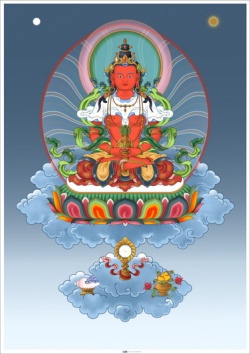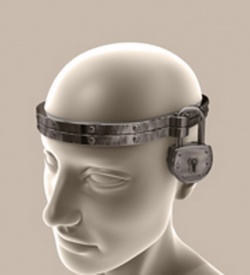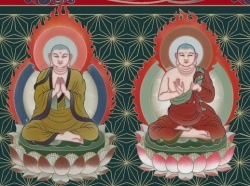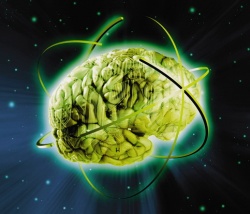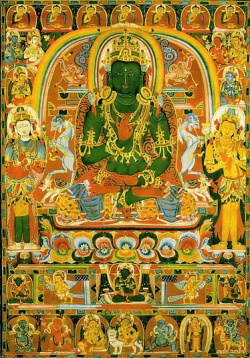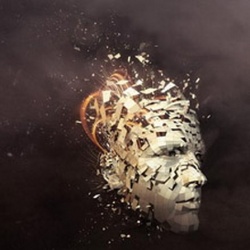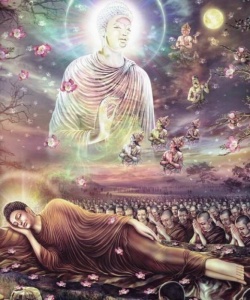Introduction to the Jonang
Introduction to the Jonang
The Jonang Tradition: Zhentong & the Kalachakra
Established in Central Tibet during the late 13th century, the Jonang tradition of Tibetan Buddhism continues on in an unbroken lineage of successive transmissions from the time of the historical Buddha Shakyamuni.
Though the Jonang were considered by Western scholars to have been extinct since their 17th century demise in Central Tibet, and were thought to have assimilated into alternative Tibetan Buddhist traditions such as the Nyingma, Sakya, and Kagyu, the Jonang are now known to have survived as their own distinct tradition.
Isolated for almost four centuries within the remote regions of far eastern Tibet, the Jonang continue transmitting their vital views and practices from the Kalachakra Tantra or "Wheel of Time Continuum" while sustaining their unique understanding of mind and reality known as "zhentong" ("shentong").
As the exclusive holders of the 6-fold vajrayoga (six yogas) of the Kalachakra completion stage, and the distinctive zhentong meditative view, this little-known tradition undoubtedly offers a fuller perspective on the whole of Buddhism in Tibet.
Zhentong: Emptiness & Buddhanature
A zhentong (gzhan stong) view is one that articulates how the ultimate nature of reality is free from or empty of everything "other" than its absolute nature.
In other words, a zhentong view understands how one's own enlightened essence or buddhanature (tathagatagarbha) is devoid of everything false and superficial.
Zhentong as a view for meditation practice regards relative reality as empty of its own intrinsic existence while ultimate reality is understood to be pure and continuously radiant.
The nature of relative reality is known as "emptiness" (sunyata, stong pa nyid), what is devoid of inherent substance, like a dream, an illusion, or a bubble in water.
Phenomena's lack of an essence on the relative level is referred to as "rangtong," literally meaning what is "empty of itself."
Accordingly, transient tangible experiences are understood to remain devoid of any inherent substance as the ultimate boundless and luminous nucleus of buddhahood within all beings is regarded as intangible and invariant.
This enlightened essence is identical to the indwelling permanently pure nature of awareness, and is understood to be the nature of mind devoid of its distorted perceptions.
Likened to an embryo or a womb, this essence provides the possibility for living beings to be reborn into completely awakened beings.
Vajrayoga: Jonang Kalachakra Practice
According to Buddhist tantric tradition, the entire Kalachakra Tantra including its generation and completion stage practices were taught by the historical Buddha, transmitted from the mythical land of Shambhala, and sustained in India before being brought to Tibet.
Among the transmissions of the Kalachakra that spread throughout Tibet, two main lineages have been maintained:
(1) the Rwa lineage and
(2) the Dro lineage.
Though there are minor branches to these two main lineages, the Dro lineage has been upheld by the Jonang tradition while the other traditions of Tibetan Buddhism have generally upheld the Rwa lineage.
As the Rwa lineage continues to transmit the empowerments and sustain the generation stage practices of the Kalachakra, the completion stage practices known as the 6-fold vajrayoga of the Kalachakra have been preserved within the Dro lineage of the Jonang tradition.
These six subtle and profound stages of yoga from the Kalachakra are:
- Yoga of Withdrawal
- Yoga of Meditative Concentration
- Yoga of Harnessing one's Life-force
- Yoga of Retention
- Yoga of Recollection
- Yoga of Meditative Stabilization
History in Shambhala & India
According to tradition, the root text of the Kalachakra Tantra was first revealed by the Buddha Shakyamuni as the magical manifestation of the Kalachakra deity to King Suchandra of Shambhala who traveled to India in order to request and receive this tantra.
At the glorious Drepung stupa in South India, a year after his complete enlightenment, it is said that the Buddha displayed the Wondrous Lunar Mansion Mandala, performed the Kalachakra empowerment and taught the tantra to King Suchandra and countless other human and non-human beings.
Upon returning to the realm of Shambhala, King Suchandra began teaching and transmitting the Kalachakra Root Tantra.
This tantra has then been passed down successively to the present 21st Kalkin of Shambhala.
King Yashas, an emanation of Manjushri then composed the Condensed Kalachakra Tantra while his son, Kalkin Pundarika composed the primary commentary on the Condensed Kalachakra Tantra titled, Vimalaprabha or Stainless Light.
Then, as the legend is told, one day in the 10th century while walking along a path in northern India, the master Jamyang Dorje had a vision of his meditation deity Manjushri who instructed him to follow the path northwards.
Along his way, Jamyang Dorje encountered an emanation of the 11th Kalkin of Shambhala who performed the entire Kalachakra empowerment and transferred this tantric lineage of realization onto him.
After meditating for 6 months on the profound yogic practices that he received from the Kalkin, Jamyang Dorje was able to transport himself to Shambhala.
While there in Shambhala, he studied the Kalachakra Tantra further with the Kalkin before returning to India.
Upon his return, Jamyang Dorje became known as "Kalachakrapada the Elder."
The Kalachakra Tantra and its commentary were then passed on from Kalachakrapada the Elder to his younger successor Shribhadra or "Kalachakrapada the Younger."
The lineage of these tantric teachings continued onto Nalendrapa (otherwise known as Bodhibhadra) and then to the Kashmiri master Somanatha.
This succession of esoteric transmission passed from Somanatha to his disciple, the Tibetan translator Dro Lotsawa Sherab Drak.
Dro Lotsawa together with Somanatha translated the root tantra along with the Stainless Light commentary from Sanskrit into Tibetan, initiating the Dro lineage of the Kalachakra Tantra in Tibet.
Early Jonangpa in Tibet
One of the Kashmiri scholar Somanatha's disciples, the 11th century Kalachakra yogi Yumo Mikyo Dorje (b. 1027) is regarded as one of the earliest Tibetan articulators of a zhentong ("shentong," gzhan stong) view -- an understanding of the absolute radiant nature of reality.
Emphasized within the Kalachakra Tantra and the Buddha's 3rd turning teachings on Buddha nature, this view would later become emblematic of the Jonangpa.
From Yumo Mikyo Dorje onwards, the Dro lineage of the Kalachakra passed on through the lineage-holders Dharmeshvara, Namkha Odzer, Machig Tulku Jobum, Drubtob Sechen, Choje Jamyang Sarma and Choku Odzer.
In the year 1294, Choku Odzer's disciple, Kunpang Thukje Tsondru (1243-1313) settled in the meditation caves (sgrub phug) on the mountains in the place called "Jomonang" in U-Tsang, South Central Tibet.
From that time onwards, the spiritual tradition associated with that place has been referred to as "Jonang,", and those who adhere to the practices that were preserved and transmitted at Jomonang have been known as the "Jonangpa."
The Jonang lineage continued on through the great masters Changsem Gyalwa Yeshe (1257-1320) and Yontan Gyatso (1260-1327).
Then in 1321, a 29 year old charismatic scholar from the Dolpo region of present-day Nepal arrived in Jomonang.
A year later, after having traveled throughout Central Tibet, he returned to the Great Mountain Retreat at Jomonang where he requested the complete empowerment and transmission of the Dro lineage of the Kalachakra Tantra and its completion stage 6-fold vajrayoga from Yontan Gyatso, the throne-holder at Jonang.
After spending several years in meditation retreat, this young master from Dolpo -- Dolpopa Sherab Gyaltsen, was requested to succeed Yontan Gyatso and assume leadership as heir to the Jonang.
From 1330 to 1333, while constructing Tibet's largest embodiment of enlightenment, the Great Stupa of Jonang, Dolpopa began formulating and codifying his meditative realizations.
In 1334, Dolpopa instructed his disciples, the translator Lotsawa Lodro Pal (1299-1353) and Lotsawa Sazang Mati Panchen (1294-1376) to prepare a new Tibetan translation of the Kalachakra Tantra and its commentary, Stainless Light.
These Jonang translations were undertaken to most profoundly explicate the hidden definitive meaning within the tantra and its commentary, serving as the textual basis for Dolpopa's innovative and syncretic teachings.
Systematizing his teachings within the cosmological schema derived from the Stainless Light commentary on the tantra, Dolpopa formulated his realizations of extrinsic emptiness or zhentong -- the contemplative understanding that one's enlightened essence is empty of everything other than the absolute nature of clear light reality.
Contextualizing his elucidations within the history of Buddhism and the Four Cosmic Eons, Dolpopa emphasized how the Kalachakra and Buddhanature teachings mark the Krtyuga or Perfect Age.
Crystallizing in his masterpieces, Mountain Dharma: An Ocean of Definitive Meaning and The Fourth Council, Dolpopa clarified how his realizations are in alignment with the Buddha's enlightened intent.
These teachings are understood to be definitive in meaning (nges don) in contrast to teachings of the degenerative age that remain interpretive in meaning (drang don).
While Dolpopa was alive, his formulations remained secretive instructions (lkog chos) that were circulated within intimate circles of his closest disciples.
During the 80 years that followed Dolpopa's death, his instructions became widely dispersed and popularized as "zhentong," allowing these teachings of the Jonangpa to flourish throughout the Land of Snows.
Dolpopa's successors Lotsawa Lodro Pal, Chogle Namgyal, Sazang Mati Panchen, and Nyawon Kunga Pal upheld the Jonang tradition after Dolpopa's passing.
Then in the 16th century, the enigmatic figure Kunga Dolchok (1507-1566) sparked a renaissance within the Jonang.
This is best represented in his collection of Tibet's essential spiritual advice titled, The One Hundred and Eight Essential Guidance Instructions of the Jonang.
This Jonang renaissance spirit carried on through Kunga Dolchok's reincarnation Jetsun Taranatha (1575-1635).
As the 16th lineage-holder in the Jonang line of succession from the time of Kunpang Tukje Tsondru, Taranatha constructed Takten Damcho Ling Monastery, and played an enormous role in the religious life of 17th century Tibet.
Known for his historical works on Buddhism, Jetsun Taranatha was a foremost expert on the tantras of the Sarma or new translation period. He compiled and arranged the Kalachakra Tantra as well as other main tantras into easily accessible practice manuals and composed some of the most lucid expositions on the 6-fold Vajrayoga ("six yogas") or completion stage practices of the Kalachakra.
The Living Tradition
After the passing away of Jetsun Taranatha in the mid-17th century, the Jonangpa became a target for political and territorial power-struggles in U-Tsang, Central Tibet.
With surmounting factional rivalries and divided allegiances amongst Jonang and Geluk patrons and the Mongol Army's solidifying of Geluk power, Jonang political and territorial influence began to wane.
As Mongol military might enthroned and endorsed the 5th Dalai Lama (1617-1682), and the Geluk political administration ruled, the Jonang were forced out of Central Tibet.
In the year 1650, the 5th Dalai Lama sealed and banned the study of zhentong, prohibiting the printing of Jonang zhentong texts throughout Tibet.
Then in 1658, the 5th Dalai Lama forcibly converted Jonang Takten Damcho Ling (Phuntsok Choling) Monastery into a Geluk Monastery — officially initiating the demise of the Jonangpa in U-Tsang.
Although the sphere of Geluk political and military influence reached to the borders of Central Tibet, it did not penetrate the far northeastern domain of Amdo, Tibet.
Here, in the remote valleys and vast countrysides of the Dzamthang, Golok and Ngawa regions, the Jonangpa took refuge and made their home.
Beginning in the year 1425 with the establishment of Choje Monastery by Chogle Namgyal's disciple Ratnashri (1350-1435), the Jonangpa have lived in the Dzamthang and surrounding counties of Amdo.
Under the imperial patronage of the Ming Court of China, the Jonangpa were able to thrive.
In fact, by the mid-16th century, the Jonangpa had consolidated their monastic complexes within the Dzamthang area in Amdo to the extent that they were the local imperial regents.
This is where the Jonangpa later gathered during their 17th century Geluk persecution.
Surviving outside the range of Geluk influence, the Jonangpa have been building monasteries and transmitting their vital teachings on zhentong and the Kalachakra Tantra ever since.
With the late 19th century luminaries such as Jamgon Kongtrul (1813-1899) and Jamyang Khyentse Wangpo (1820-1892), the Rime or eclectic movement was born in Kham, Eastern Tibet.
Sparked by the writings and compilations of these figures, including Kongtrul's Five Treasures, there was the occasion for a re-kindling of interest in the Jonang tradition and zhentong literature.
Inspiring many of the great masters from Kham at this time such as Dza Patrul Rinpoche and Jamgon Mipham, the Jonang Kalachakra completion phase practices and distinctive zhentong view gained attention from other traditions as well.
Meanwhile this period continued to produce some of the greatest masters of contemporary Jonang thought up through the late 20th century, including Bamda Geleg (1844-1904) and Khenpo Ngawang Lodro Drakpa (1920-1975).
In the 1960's, many of the great living exemplars of the Jonang were forced out of their monasteries, and they fled into the countryside of Amdo where they wandered as nomads or took shelter in caves as yogis.
Over the next two decades, the Jonangpa lived without homes in their homeland, gathering during the summer for their annual rains-retreat in order to continue to transmit their lineage.
After the Cultural Revolution in 1976, the Jonangpa began returning to their monasteries where they have been rebuilding monasteries and reviving their unique spiritual tradition up to today.
Source
jonangfoundation.org
jonangfoundation.org
jonangfoundation.org
jonangfoundation.org
